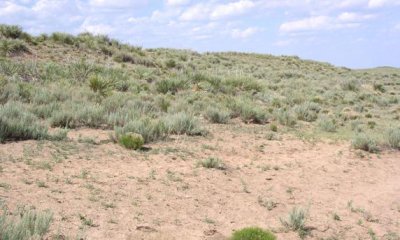
Sand Hills 16-22" PZ
Scenario model
Current ecosystem state
Select a state
Management practices/drivers
Select a transition or restoration pathway
-
Transition T1A
Absence of disturbance and natural regeneration over time, may be coupled with excessive grazing pressure
More details -
Restoration pathway R2A
Reintroduction of historic disturbance regimes, may be coupled with rangeland seeding
More details -
Transition T2A
Absence of disturbance and natural regeneration over time, coupled with excessive grazing pressure
More details -
Restoration pathway R3B
Removal of woody canopy and adequate rest from defoliation
More details - Restoration pathway R3B More details
-
No transition or restoration pathway between the selected states has been described
Target ecosystem state
Select a state
Description
Tallgrass/Shrub/Forb Community (1.1) is a mixture of tallgrasses (50-60 percent), shrubs (40-50 percent) and perennial forbs (10-15 percent). A varying amount of annual forbs can be found depending on the moisture situation in a given year. The dominant tallgrasses were sand bluestem, giant sandreed, little bluestem and the taller dropseed species.
Submodel
Description
The plant community is dominated by shrub canopy(>80%) such as sand sagebrush and skunkbush with approximately 20 % perennial grasses (mainly midgrasses) and numerous annual and perennial forbs. Some tallgrass remnants are scattered throughout the site.
Submodel
Description
The Shrub Dominant/Annual Forbs/Few Grasses community has >90% woody canopy of sand sagebrush and skunkbush sumac, on some sites yucca will be a high percent of the total canopy. Annual forbs and grasses make up approximately 10% or less of the total composition with numerous bare areas scattered throughout the site.
Submodel
Mechanism
The Tallgrass/Shrub State can transition to the Shrub/Midgrass State if the plant community is grazed heavy and continuously, no fire, and no brush management practices are implemented.
Mechanism
With the implementation of various conservation practices such as Prescribed Grazing and Brush Management, the Shrub/Midgrass State can revert back to the Tallgrass/Shrub State.
Relevant conservation practices
| Practice | External resources |
|---|---|
|
Brush Management |
|
|
Prescribed Grazing |
Mechanism
With continued heavy grazing pressure, no fires, no brush management, and no pest management, the Shrub/Midgrass State transitions to the Shrubland State.
Mechanism
The Shrubland State can be restored to the Tallgrass/Shrub State with the implementation of associated conservation practices including Prescribed Grazing, Brush Management, and Pest Management over a four to five-year period.
Relevant conservation practices
| Practice | External resources |
|---|---|
|
Brush Management |
|
|
Prescribed Grazing |
|
|
Integrated Pest Management (IPM) |
Mechanism
The Shrubland State can be restored to the Tallgrass/Shrub State with the implementation of associated conservation practices including Prescribed Grazing, Brush Management, and Pest Management over a four to five-year period.
Relevant conservation practices
| Practice | External resources |
|---|---|
|
Brush Management |
|
|
Prescribed Grazing |
|
|
Integrated Pest Management (IPM) |
Model keys
Briefcase
Add ecological sites and Major Land Resource Areas to your briefcase by clicking on the briefcase (![]() ) icon wherever it occurs. Drag and drop items to reorder. Cookies are used to store briefcase items between browsing sessions. Because of this, the number of items that can be added to your briefcase is limited, and briefcase items added on one device and browser cannot be accessed from another device or browser. Users who do not wish to place cookies on their devices should not use the briefcase tool. Briefcase cookies serve no other purpose than described here and are deleted whenever browsing history is cleared.
) icon wherever it occurs. Drag and drop items to reorder. Cookies are used to store briefcase items between browsing sessions. Because of this, the number of items that can be added to your briefcase is limited, and briefcase items added on one device and browser cannot be accessed from another device or browser. Users who do not wish to place cookies on their devices should not use the briefcase tool. Briefcase cookies serve no other purpose than described here and are deleted whenever browsing history is cleared.
Ecological sites
Major Land Resource Areas
The Ecosystem Dynamics Interpretive Tool is an information system framework developed by the USDA-ARS Jornada Experimental Range, USDA Natural Resources Conservation Service, and New Mexico State University.




